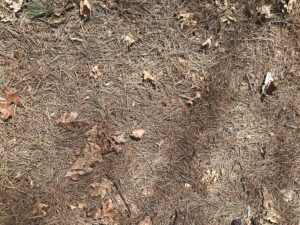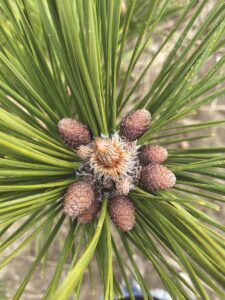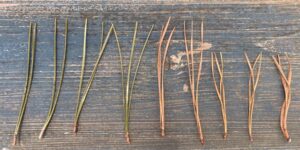WELLFLEET — Moving down the path that runs along the southern edge of Dyer Pond, I felt the cold northeast air move over the pond and chill my windward side. A midday April sun warmed my southern half. I stepped over the knobby pine roots through inkberry and clethra, watching the ground, my gaze focused a few steps in front of me. I was a long way down the path before I noticed its texture, an endless crosshatching of pine needles, thousands of intersecting lines in tans and browns.

Pine needles are such an everyday thing here that it is easy to overlook them. But standing on that path I realized that the brown, twisted bundles of their needles covered nearly every surface I could see. All through the underbrush were rafts of them. Pincushions of moss had pine needles stuck in them, poking out in all directions. Clumps, interlaced and matted, were piled years deep at the stems of huckleberries. A sinuous line of needles formed the wrack line that ringed the pond’s edge.
I looked up at the trees. The forest here is pitch pine. Pinus rigida are native to New England. Their dark, lichen-flecked trunks are often gnarled and twisted, as if recording lifetimes of slow-motion dance. When I was a kid, a grumpy old man told me our pines were like this because all the straight-growing stock had been harvested by the European colonizers for ship- and home-building. What was not fit for use — the knotted, low-growing specimens by the oceanside — were, he wanted me to believe, what had repopulated the mostly clear-cut Cape. But now I know that the short wind-pruned trees, distorted by their continual encounters with storms, are the same species as the straight-growing ones.

The canopies of these pines are masses of needles, too — billowing green clouds made entirely of sharp lances. Where I stood, the needles were of such great volume that after sunlight and air they were most abundant material in my surroundings.
The needles are a pine’s own version of a leaf. They are tough, tolerating hot sun, withstanding deep cold. The needle is one of many adaptive features of the pine that have allowed it to grow in a wide range of environments. Because of the pine needle’s thick skin and a series of tiny pores called stomata that open and close along its length, the needles can retain moisture in dry and windy environments, depending on conditions.
The needles also provide the advantage of year-round photosynthesis. On a winter day when water and light are available and temperatures are above freezing, the pines will carry on the magic of turning the sun’s energy into sugars.
Each bundle of pine needles will stay on the tree for two to three years before dropping off in the fall to be woven into that blanket on the floor.
Pitch pine needles look like blades of grass tied together at one end. They are usually in bundles of three, an identifying trait of the species, but may have only two or up to five. A tight, scaly base, called a fascicle, holds them like a hand holds a bouquet of flowers. The needles are usually about the length of human fingers — those of younger humans where there is more wind, and adult fingers where there is shelter and water.

They are a waxy matte green when alive. One side of each needle, the upside, has a gentle convex curve, a slight doming, that carries though its length. The underside has a series of ridges running in parallel the length of the needle. The middle ridge is the most prominent, providing a spine of support.
The clustered needles are mostly straight, but sometimes a gentle twist is noticeable. As they fall away from the tree and begin to dry, the needles contract and, in slow motion, begin to twist and spiral like tiny sculptures, beautiful feats of natural engineering.
Paving our paths, covering our lawns, they are useful and beautiful. Maybe better not raked into piles and wheelbarrowed away but allowed to blanket our world and grow into great carpets to be walked on daily, releasing their perfume and softening our steps.



